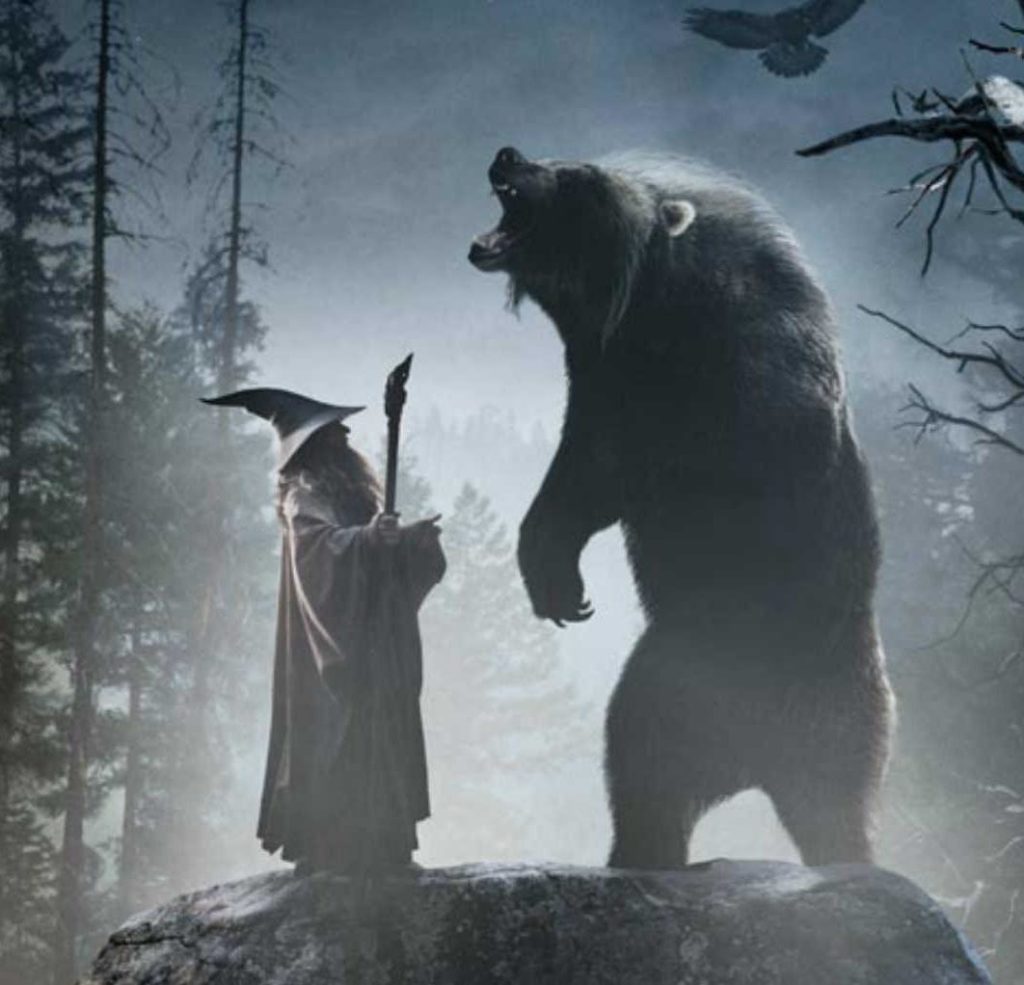‘The Hobbit’ Story Group 7: Queer Lodgings
 One year ago The Hobbit: An Unexpected Journey ended just before this chapter begins. My church reading group kept right on going — and now we’ll resume with the discussion points I wrote back then, here on SpecFaith. Lord willing, this series will continue through mid-December, ending before The Hobbit: The Desolation of Smaug’s Dec. 13 (U.S.) release.
One year ago The Hobbit: An Unexpected Journey ended just before this chapter begins. My church reading group kept right on going — and now we’ll resume with the discussion points I wrote back then, here on SpecFaith. Lord willing, this series will continue through mid-December, ending before The Hobbit: The Desolation of Smaug’s Dec. 13 (U.S.) release.
As with the first film, however, I can only make an educated guess at when the film will end. So far its trailers have shown nothing beyond the Dwarves’ arrival in Smaug’s cave, after the titular dragon flees for (to the Dwarves, at first) unknown reasons. So that’s my guess.
By the time you read this, I’ll be moved nearly half a continent away, from central Kentucky to central Texas, north of Austin. Fortunately there is a nice movie theater here that shows bright 3D films in high frame rate, as my wife and I plan to see The Hobbit part 2. Will you see the film? What do you hope most will be great? What do you not anticipate (Tauriel)?
This chapter begins how the film should begin: with Gandalf escorting the company to yet another episode with a fantastic creature. In this case Bilbo, Dwarves, and readers meet a man unlike any other in Middle-earth: the shapeshifter Beorn. You could call him a “were-bear,” except that as Hermione notes about werewolves in Harry Potter and the Prisoner of Azkaban, were-creatures cannot control their transformations. Beorn can, and uses his power — which has no detailed origin as Tolkien gives other creatures — to great effect.
Note I didn’t say positive effect. A simplistic “cast of characters” list would put Beorn on the side of the “good guys,” especially after he shows up busting goblin heads at the Battle of Five Armies. (We all know The Hobbit film director Peter Jackson won’t resist expanding Beorn’s battle role.) Yet Beorn is at best vague. Were-bear? More like medieval gangster.
Chapter 7: Queer Lodgings
- Read chapter 7, pages 106 (The next morning …) to 114 (“… about to tell you”).
- What would it be like to fly on the back of an eagle? Do you believe this is a Biblical allusion (“they shall mount up with wings like eagles,” Isaiah 41:31) or coincidence? How would we know the difference between a Biblical allusion and coincidence?
- There was a little cave (a wholesome one with a pebbly floor) (page 107). Does this make sense to you? How could a cave be more wholesome, at least to Bilbo and the others?
- “… I have some other pressing business to attend to.” (page 109) What does Gandalf’s announcement of his leaving mean to the others? (Hint: might this be an end to those deus ex machina escapes from impossible situations, and they know it?) Here we see that Gandalf has his own agenda, and isn’t at their beck and call. Any similarities?
 Gandalf says of Beorn: “He is a skin-changer. He changes his skin: sometimes he is a huge black bear, sometimes he is a great strong black-haired man …” (page 110). What about a “skin-changer” or “shape-shifter”? Some Christians object to having these in stories. One writer says (discussing another fantasy book): “Christians should remember that shape-shifting has been part of sorcery and shamanism through the centuries.” 1 Is this true? How would we know? Should we take this seriously? What does Scripture say (if anything) against trying to take the shape of an animal? Is this even possible in reality?
Gandalf says of Beorn: “He is a skin-changer. He changes his skin: sometimes he is a huge black bear, sometimes he is a great strong black-haired man …” (page 110). What about a “skin-changer” or “shape-shifter”? Some Christians object to having these in stories. One writer says (discussing another fantasy book): “Christians should remember that shape-shifting has been part of sorcery and shamanism through the centuries.” 1 Is this true? How would we know? Should we take this seriously? What does Scripture say (if anything) against trying to take the shape of an animal? Is this even possible in reality?- Read chapter 7, pages 121 (It was full morning …) to the chapter’s end.
- Earlier, Gandalf used subtle flattery and an appeal to curiosity to smuggle one Hobbit and then all 13 Dwarves into Beorn’s house and hospitality. Is this deception on the wizard’s part — or perhaps a “shrewd as serpents” kind of game, which Beorn honors?
- A goblin’s head was stuck outside the gate and a warg-skin was nailed to a tree just beyond. Beorn was a fierce enemy. (page 124) Is Beorn a “good guy” or “bad guy”? Are his actions honorable? Do we sometimes need “rough characters” like Beorn to take care of business, or could we (even as heroes in the story) find a “better way”?
- How do the hints, foreshadowing, and even the sound of the name Mirkwood affect us?
- Three times now the group has fought a battle, then taken a rest. What might make us think this time will be different? Might those “coincidental” escapes have been planned.
- The Deadly Magic of Potter Movies: The Order of the Phoenix is not “just fantasy!”, Berit Kjos, dated 2007 ↩










































Beorn is one of my favorite characters in the story too and I can’t wait to see him come to life in the movie. I would like to make two brief comments re shapeshifting. Whereas I agree with the sentiment expressed by Mrs. Kjos that you quote and document re Harry Potter, she like so many others is simply incapable of accepting the notion that Middle-earth, Narnia and other fantasy worlds are indeed OTHER WORLDS where God’s “rules” if you will about certain things may not necessarily be the same. HERE shapeshfting IS the province of the pagan and the demonic; not necessarily so in another different world God has created. The other thing I want to say is when you ask the question is shapeshifting possible “in reality,” that sounds a lot like Christian Rationalism to me, i.e. “The Devil can’t do that” — or hardly anything really, outside messing with our minds. Christians who’ve experienced the Devil’s Hand don’t ask the question you raise, they know better — by that same experience. And I cannot say in all charity, to echo Derek Prince, that in all charity it is experience I wish upon you. Soli Deo Gloria!
I’m more inclined to think that the only “real” shapeshifting is a reflection of God’s power. Primarily I’m thinking of angels manifesting as humans, but there’s also God’s rod-turned-snake and back again. Are there other examples in Scripture of one thing turning into another? I can’t think of any off the top of my head.
Now Satan inhabiting other creatures–that’s different, and I don’t think that comes close to shapeshifting.
Stephen, I found your characterization of Beorn as “more like medieval gangster” surprising. I find him to be quite close to Aslan–not safe, yet judging by his enemies, he’s definitely good. Now i he had a dwarf head on the pike or a skin of a hobbit, it would be a different matter.
But he won’t be manipulated or used. He is an independent, which makes him harder to pin down. He reminds me in some respects of Tom Bombadil. I find it interesting that Tolkien seemed to feel the need to include these indendents in his stories.
Becky
Beorn is scary, but awesome. Scary-awesome. I suppose I was thinking of a good-guy gangster, or perhaps the Grizzly Adams of Middle-earth.
He’s a fusion of a druid and a berserker, in the literal sense; berserker means bear-shirt, and before sexy werewolf days one way you became a werewolf was by wearing the skin of one. I think in the Volsung they had a myth of two brothers who became wolves by wearing wolf-shirts, so he might have extended the idea to bears.
He’s scary and cool in a moderate form of how the old pagan people were scary and cool. You’d have extreme courage mixed in with cruelty or wildness.
Charity accepted with gratitude, and I hope I return it below, brother.
We’re agreed for sure about the “other worlds have other rules” truth. (Bear in mind that these discussion questions were originally for a live church reading group.)
But I do wish to suggest a form of “regulative principle” about the Devil’s deeds. Nothing in Scripture supports the notion that the Devil can literally shapeshift; even the “angel of light” appearance is a metaphor to describe his attractiveness, for we do not actually see the Devil or his minions visibly manifest. Far more outside the bounds of Biblical-based rationalism is a notion that human beings in the Devil’s service could actually possess the power to shapeshift. To think otherwise is, I fear, abject mysticism and a failure to discern fantasy from reality. But even if this were true of demons, or humans practicing dark arts, Scripture only warns against resisting the devil’s temptations — not fearing any shapeshifting.
I feel like I need to go copy-paste that discussion we just had about whether looking at tea leaves looks like witchcraft and certainty and efficacy and all that, ’cause this discussion just raises those same feelings in me of “this misses the point” and “who even cares about witchcraft?”
Here is where our very approaches to the problem apparently differ. In response to your question, I very definitively say, “God does, as shown in Deuteronomy 18 and at least two texts in the New Testament.”
But God was speaking to an audience that believed in the possibility and efficacy of such stuff, right? Why would we have to worry about staking boundaries around it when the vast majority in our culture doesn’t take it seriously? Is it just the meaning in ritual? I think any pagan meaning has been fairly well sanitized by now.
That’s not at all what I see in the majority of culture, though I don’t even need to prove that about non-Christians. Christians alone buy into a vast assortment of un-Biblical mysticism, though with an evangelical veneer. The wide array of materials that promise to give you “life direction” or help you practice listening so you can “hear from God” (the first-person “devotional” Jesus Calling is just one recent example) confirm that evangelicals, for all their good intentions, are wide open to practicing “divination” apart from the means God clearly said He would use to reveal Himself, culminating in Christ. That, however, doesn’t include notions such as evil, “demonic,” shape-shifting, which arise from popular myth and not Scripture’s actual forbiddings.
So I take it you’re not a fan of the “enthusiastic” denominations.
Not sure about specific denominations. But Christian leaders or materials that emphasize ecstatic emotionalism over and above full-mental engagement do commit error. It’s the opposite error of those who emphasize rational thinking above emotional response. The Scriptures I’ve cited condemn either (such as Paul’s insistence in 1 Cor. 14 that all things, even the practice of wondrous spiritual gifts, “be done decently and in order”).
I am looking forward to Tauriel with about the same amount of joy that I am express at my cold sending all its slime down my throat right now. Even her name (literally wood-elf) gives the “this-is-gonna-be-bad” vibes. Not because she’s an alteration, but because SHE. IS. NOT. IN. THE . BOOK. WHY do the producers feel the need to give her a poster?
Looking forward to Beorn, Smaug the Greatest and Chiefest of Calamities, and anything with Ori.
But they had to do it because: women.
Women will like an additional female character, even one not in the book.
Oh wait. You appear to be a woman yourself. Now this is ever so confusing.
They added Galadriel for the White Council scenes–that’s the sort of addition I can get behind, because it’s canonically plausible. But Tauriel seems to be only there for the action scenes, which bugs because it implies only “action” woman
are powerful–go to the appendices, go to the Silmarillion, read about Galadriel’s past.
She says ‘through the ages of the world we have fought the long defeat,’ from the day Morgoth (the original big bad) stole the Silmarills, through the Wars of Beleriand (in which every good elf was getting killed by other good elves) and the War of the Rings. If you don’t acknowledge the guts that takes, you’re being hypocritical.
I’m a woman too, and Tauriel annoys me. I am tired of sword wielding spitfires. And frankly, doesn’t it disservice women to imply this is the only way to be strong? My mom is a homemaker, has five kids (ages 21 to 6), has graduated two, teaches the other three, does administrative work for my dad–oh, and she’s also a runner. All of that takes strength–not just physical strength but also a planning head and lots of patience and discipline.
Sorry, little rant there. About Beorn…I haven’t searched what the Bible says about shapeshifters, so no informed opinion there. But I do want to see the film, and I think the parts PJ and Co. got RIGHT will far make up for Tauriel (and Bard, for that matter; I don’t like the way they’ve portrayed him. Bard was grim-faced, a pessimist, and since Tolkien usually mentioned family relationships, I always thought Bard got married after the events of The Hobbit).
Glad to see the reading group posts have returned! I missed those!
Blessings,
Literaturelady
Amen to that.
Two points in Jackson’s favor, though. One, he and the others did learn their lesson, as explored about two years ago in Lord of the Fantasies: Beyond the Swordfights. Two, Evangeline Lilly herself was an in-depth Middle-earth fan long before the films were even announced, and herself was quite the fan of the books who was reluctant to see those films, for fear they would offer a horrendous adaptation.
So even if Tauriel is a clunker of an annoying female character, it may not be due to the actress who plays her. (That or Jackson and Co. have their propaganda with their actors — e.g., “they’re fans just like you” — down to a science!)
Okay, that relieves my anxiety slightly, Only slightly. The marketing, on the other hand….I still wish they’d leave her out of marketing–this is supposed to be a story about the Dwarves, Gandalf and Bilbo–sure, add some stuff about the Necromancer or Thranduil, but they’re in the book. Putting her in the trailers smacks of spotlight-stealing Sue.
I know, right? On yet another promotional poster, there she is, right next to the title The Hobbit (and I maintain that her arms are not developed enough for professional archery; I did the research). I had to hunt to find Bilbo, poor fellow.
This isn’t just a problem in LOTR. I was visiting a Doctor Who scholarly criticism blog where someone posted this image (http://3.bp.blogspot.com/_WXcz4PPPgx8/S08ek5nWEVI/AAAAAAAAAH4/79QBVzVG2Y4/s320/doctor_who_2005_promo.jpg,) in which Rose takes center stage, the TARDIS is in the background, and you can barely see the Doctor’s face at all. I think I’ll keep an eye out for it in the future.
I read those interviews, and Evangeline Lilly seems like a nice person. So I guess the problem is with the screenwriters who think female viewers want warrior women, which are now as cliche as the damsels in distress once were (and neither of which I like). And I am quite thankful that Peter Jackson didn’t have Arwen show up at Helm’s Deep!
As I have now seen the film, I must confess my fears were justified.